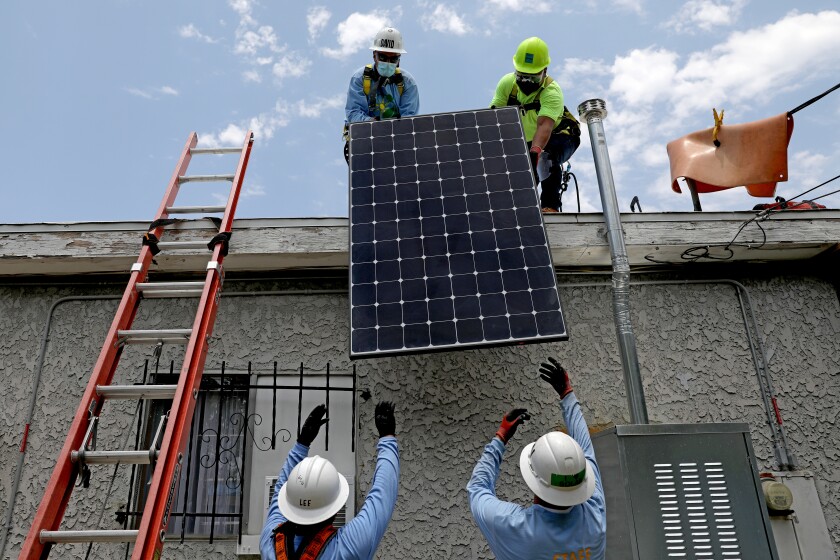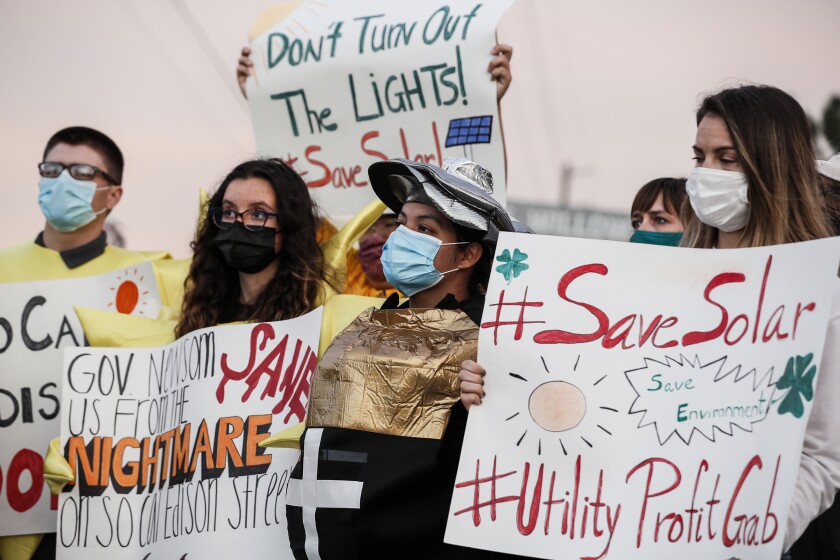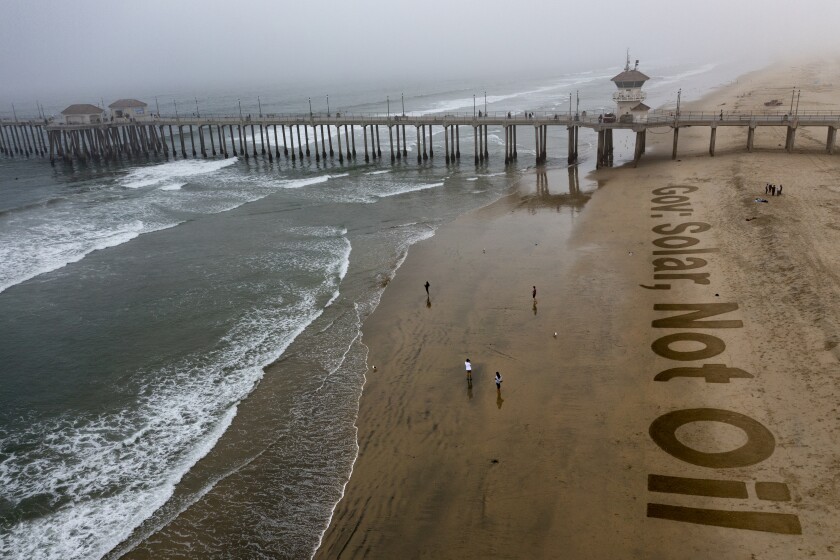[ad_1]
California officers wish to slash bills for rooftop solar energy, announcing the adjustments would lend a hand the state reach 100% blank power whilst preserving the lighting fixtures on, combating electrical energy charges from emerging and inspiring folks to put in batteries.
However photo voltaic executives are livid with the adjustments, announcing they might backfire and crater a thriving business.
The proposal from Martha Guzman Aceves, one in every of 5 participants of the California Public Utilities Fee, would revamp an incentive program known as web power metering that has helped the state grow to be a countrywide solar energy chief, with greater than 1.3 million rooftop and different small-scale programs put in. The photo voltaic business and local weather exchange advocacy teams are lobbying Gov. Gavin Newsom and his appointees at the utilities fee to stay this system’s elementary tenets unchanged.
In an interview, Guzman Aceves stated web metering wishes to conform to replicate California’s converting power wishes. The Golden State’s energy grid is more and more flooded through solar power throughout the afternoon however strained on sizzling summer time evenings, when thousands and thousands of folks throttle up their air conditioners to deal with prime temperatures made worse through the local weather disaster.
Decreasing call for for planet-warming fossil fuels reminiscent of diesel and herbal gasoline throughout that “web height” duration within the night, Guzman Aceves stated, is her overriding objective.
She and her personnel crafted a plan to segment out web metering that can inspire new and present photo voltaic shoppers so as to add battery garage programs that may financial institution blank power for after darkish, she stated. Amongst different provisions, a brand new “garage evolution fund” would supply bills for properties that have already got photo voltaic panels so as to add garage.
“There’s an enormous alternative right here for us to get extra out of those shoppers to give a contribution to the online height,” Guzman Aceves stated.
Different parts of the commissioner’s proposal would advised Californians to modify from gas to electrical cars, and from herbal gasoline furnaces and stoves to electrical home equipment fueled through photo voltaic and wind power, Guzman Aceves stated — key items of California’s warfare on local weather exchange. For example, properties and companies that upload photo voltaic panels could be allowed to construct a lot larger programs than is these days allowed below web metering, to strengthen life which can be more and more powered through electrical energy.
“I feel the proposal is powerful,” Guzman Aceves stated. “It’s interested in what we jointly want, to get off of fossil fuels.”

A Grid Choices group installs rooftop photo voltaic panels at a house in L.A.’s Watts group in June.
(Gary Coronado / Los Angeles Occasions)
Sun executives and local weather activists, despite the fact that, stated the proposal would handiest hinder California’s competitive local weather targets.
Walker Wright, vice chairman of public coverage at San Francisco-based Sunrun, the country’s biggest rooftop photo voltaic installer, was once in a similar fashion displeased, announcing in a written commentary that Guzman Aceves’ proposal would “impose the absolute best discriminatory fees on photo voltaic and effort garage shoppers within the U.S., striking rooftop photo voltaic and batteries out of succeed in for numerous households.”
Wright additionally stated the proposed adjustments are “opposite to the state’s targets of addressing local weather exchange and getting rid of widespread blackouts” — a connection with the software business’s follow of shutting down the electrical grid in positive puts throughout dry, windy prerequisites to stop wildfire ignitions. Sun supporters see the ones “public protection energy shutoffs” as a formidable argument for encouraging rooftop programs paired with batteries that may function a backup energy supply when the grid is going down.
“Most effective the wealthiest Californians will be capable of have the funds for rooftop photo voltaic, shutting out colleges, small companies, and the typical circle of relatives from our blank power long term,” stated Abigail Ross Hopper, president of the Sun Power Industries Assn., a business crew, in a written commentary. “The one winners as of late are the utilities, which can make extra income on the expense in their ratepayers.”
Guzman Aceves’ proposed determination, which was once launched Monday, endorses the argument made through the state’s biggest investor-owned software firms — Southern California Edison, Pacific Gasoline & Electrical and Sempra Power — that web metering subsidizes richer families that may have the funds for rooftop photo voltaic on the expense of lower-income families that may’t.
The utilities estimate that “value shift” at $3.4 billion once a year, a determine hotly disputed through the photo voltaic business and local weather activists, who say rooftop panels create many public advantages that aren’t incorporated within the calculation, together with the well being advantages of much less air air pollution from fossil fuels and the associated fee financial savings from restricting the desire for brand spanking new energy vegetation and transmission strains. Rooftop photo voltaic additionally doesn’t require paving over undisturbed land, in contrast to sprawling wilderness photo voltaic farms that may tear up delicate ecosystems.
Software firms have led the fee for decrease rooftop photo voltaic incentives, along politically robust exertions unions representing their workers, who’ve a vested pastime in protective the monopoly software trade style. However they’re no longer by myself.
Two influential client watchdog teams, the Software Reform Community and the state’s Public Advocates Place of work, have joined the utilities in arguing for decreased incentives for rooftop photo voltaic. A handful of distinguished environmental teams, together with the Herbal Assets Protection Council and the California Environmental Justice Alliance, have additionally argued this system isn’t equitable.
Mohit Chhabra, a senior scientist at NRDC, known as the proposed determination “a robust North Megastar.” He was once particularly proud of a plan to spend $600 million over 4 years to convey blank power to low-income and polluted neighborhoods, perhaps via incentives for batteries or in the community constructed “neighborhood photo voltaic” amenities that serve families not able to put in their very own photo voltaic.
The Software Reform Community praised the commissioner’s proposal, too, with personnel lawyer Matthew Freedman describing it as “a step in the suitable route” that prioritizes low-income families “who’ve been left at the back of below the present program.”
Southern California Edison presented equivalent reward, calling the verdict “a significant step towards modernizing California’s rooftop photo voltaic program” that can “scale back the monetary burden on non-solar shoppers who’ve sponsored web power metering.”

Westlands Sun Park within the San Joaquin Valley, which is being constructed on retired farmland.
(Carolyn Cole / Los Angeles Occasions)
Guzman Aceves thinks the $3-billion value shift estimate is “at the low facet” of what non-solar ratepayers are in reality paying for web metering. If, as a substitute, the state had been to spend an identical quantity development huge photo voltaic farms within the wilderness or on retired farmland — which generate electrical energy extra affordably than rooftop programs as a result of economies of scale — it might triple its photo voltaic capability, a comparability that is helping illustrate “how a lot we’re spending and what sort of we’re getting” from the rooftop program, Guzman Aceves stated.
The commissioner desires to make a number of really extensive adjustments to web metering.
First, she would slash the bills that newly enrolled photo voltaic shoppers obtain for the electrical energy they ship to the facility grid when their programs generate greater than they want. As a substitute of being compensated on the retail price — the similar price they pay for electrical energy from the grid — they might be paid at a miles decrease price referred to as the “have shyed away from value.” That will quantity to about 5 cents according to kilowatt-hour of electrical energy, down from 20 to 30 cents as of late, in keeping with the California Sun & Garage Assn.
2d, new photo voltaic shoppers would pay a per month “grid participation fee” of $8 according to kilowatt of solar energy monthly to lend a hand duvet the prices of keeping up the grid, reminiscent of software protection tasks to scale back the danger of wildfire ignitions. Web metering critics say that form of “mounted fee” can be sure that a very powerful software expenditures aren’t simply paid for through lower-income families.
A house with a six-kilowatt device could be charged $48 a month, or $576 a yr. Low-income properties could be exempt.
The proposed determination responds to considerations raised through photo voltaic firms — specifically, that decreasing web metering fee and including per month charges would crash the photo voltaic marketplace — through making a “marketplace transition credit score” of as much as $5.25 according to kilowatt monthly for properties that upload photo voltaic panels inside of 4 years of the brand new program taking impact. The dimensions of the to be had credit score would drop every of the ones 4 years, however shoppers who upload photo voltaic — without or with batteries — would lock within the financial savings for a decade.
Guzman Aceves stated the credit are designed to create a “payback duration” of 10 years for brand spanking new photo voltaic shoppers, that means that’s how lengthy it could take them to make again their prematurely funding via decrease electrical expenses. Payback sessions these days hover round 5 years. The software firms had proposed web metering adjustments that might build up them to kind of twenty years.
Guzman Aceves described concentrated on a 10-year payback duration as a judgment name.
“I individually know that for a few of my bills, I lately installed a water heater, and that has a 10-year payback,” she stated.
Sun executives, despite the fact that, aren’t satisfied the commissioner’s proposal would in reality lead to 10-year paybacks — and even though it did, they are saying, that’s a ways longer than the seven years or much less this is had to convince most of the people to put money into photo voltaic.
Bernadette Del Chiaro, government director of the California Sun & Garage Assn., an business business crew, stated in an e mail that she was once “surprised at how dangerous” the proposed determination is. The concept it’s pro-batteries, she stated, “couldn’t be farther from the reality,” with new per month charges making use of to all solar-powered properties and companies, whether or not or no longer they have got power garage.

Dozens of folks joined a November protest arranged through the Sun Rights Alliance out of doors a Southern California Edison place of job in Lengthy Seaside. The protesters known as for Gov. Gavin Newsom to give protection to web metering.
(Robert Gauthier / Los Angeles Occasions)
Del Chiaro additionally identified that most of the adjustments may take impact once Would possibly. She stated that’s no longer just about sufficient time for the business to reorient itself round power garage, particularly with simply 15% of houses going photo voltaic as of late including a battery.
“How on the planet are we intended to promote, to not point out manufacture and distribute, that many batteries in that time frame?” she requested. “We want to ramp up the battery marketplace, however making photo voltaic dearer within the subsequent 5 months is the way you kill all the disbursed era marketplace, no longer the way you force a garage marketplace.”
Houses and companies that have already got photo voltaic could be switched from web metering to the brand new “web billing” program envisioned through Guzman Aceves 15 years after their programs had been put in. She instructed that are supposed to give the ones photo voltaic shoppers — who knowledge display are wealthier and whiter than the state as a complete — greater than sufficient time to make again their investments.
Present photo voltaic shoppers that transfer to the brand new program — in addition to new photo voltaic shoppers — would additionally pay upper charges for energy from the grid throughout occasions when the software device is strained, reminiscent of sizzling summer time evenings, and decrease charges at different occasions.
All software shoppers are these days moving to these “time of use” charges, whether or not or no longer they have got photo voltaic. However below Guzman Aceves’ proposal, the adaptation between “height” and “off height” fees could be even larger for photo voltaic properties, to advised them so as to add batteries that might retailer affordable electrical energy throughout the day and discharge within the night, decreasing pressure at the grid. These kind of charges additionally paintings smartly for folks with electrical automobiles to fee or properties heated and cooled through electrical warmth pumps, supporters say.
The proposed determination would handiest impact shoppers of Edison, PG&E and Sempra subsidiary San Diego Gasoline & Electrical. Shoppers of publicly owned utilities such because the Los Angeles Division of Water and Energy wouldn’t see their photo voltaic incentives exchange.
The earliest the Public Utilities Fee may vote at the proposal could be Jan. 27, after a public remark duration.
Give a boost to our journalism
Your strengthen is helping us ship the scoop that issues maximum. Subscribe to the Los Angeles Occasions.
Via then the company may have a brand new president, with Marybel Batjer stepping down and being changed through Newsom’s power marketing consultant, Alice Reynolds, on Dec, 31. Guzman Aceves may also be leaving the fee on the finish of this week, after being appointed through President Biden to guide the southwestern area of the U.S. Environmental Coverage Company.
Particularly if Newsom strikes temporarily to switch Guzman Aceves, he will have a large number of sway over the overall determination — if he desires to.
However photo voltaic advocates would possibly to find themselves disillusioned. Responding to questions from The Occasions, Newsom spokesperson Erin Mellon stated handiest that the governor “does no longer direct impartial forums or folks on find out how to take care of any problems which can be in entrance of them.”
That’s regardless of photo voltaic firms and local weather advocacy teams lobbying the governor to push the fee of their route.
The Save California Sun marketing campaign, which incorporates greater than 600 organizations, says it delivered 120,000 public feedback supportive of web metering to Newsom closing week. The marketing campaign estimated Monday that even after the “marketplace transition” credit proposed through Guzman Aceves, the commissioner’s plan would upload $57 monthly to the invoice paid through the typical solar-powered house.
Laura Deehan, who leads the advocacy crew Atmosphere California, when compared the proposal to “the similar of tying cement blocks to our ankles as we race to transition clear of fossil fuels,” announcing it could derail California’s trail to 100% blank power.
“That trail calls for a sustained dedication to rising rooftop photo voltaic,” Deehan stated in a written commentary. “The momentum that rooftop photo voltaic has now would lend a hand us succeed in our objective — however to intestine web metering is to intestine that momentum.”

A surfer heads for the water as photo voltaic advocates end writing a 200-foot message within the sand in Huntington Seaside, close to the web page of an October oil spill. The message — “Gov: Sun, Now not Oil” — was once supposed for Gov. Gavin Newsom, urging him to give protection to the rooftop photo voltaic incentive program referred to as web metering.
(Allen J. Schaben / Los Angeles Occasions)
The software business and its allies have sought to border web metering as unfair subsidy serving to the wealthy on the expense of the deficient, and whiter communities on the expense of folks of colour. The photo voltaic business counters that the generation is attaining extra folks because it will get less expensive.
Information from Lawrence Berkeley Nationwide Laboratory display that 12% of California photo voltaic adopters in 2019 had earning beneath $50,000, and an extra 29% had earning between $50,000 and $100,000, up from 9% and 24%, respectively, a decade previous.
The Inexpensive Blank Power for All marketing campaign, which lists greater than 100 numerous supporters however whose sole funders are the software firms, issued a commentary from spokesperson Kathy Fairbanks announcing the proposed determination “acknowledges we will develop rooftop photo voltaic in California whilst taking steps to scale back inflated subsidies that experience put an unfair value burden on renters, seniors, deprived communities and different running Californians who don’t be able or approach to put in rooftop photo voltaic programs.”
Fairbanks estimated that properties that don’t have photo voltaic are these days paying $245 a yr to subsidize those who do.
The Save California Sun marketing campaign, in the meantime, launched a commentary from Pastor William Sensible Jr., president of the Southern Christian Management Convention, who described the Public Utilities Fee’s proposed determination as a “software benefit clutch,” announcing it could “take California again to a time when photo voltaic was once a luxurious for the rich and out of succeed in for our communities.”
“This can be a tale as outdated as this nation: A brand new generation is evolved, systems and insurance policies are presented to lend a hand customers to undertake the generation and convey down the prices through the years, and simply when folks in Black and brown communities are starting so that you could have the funds for the generation and have the benefit of it — the systems and insurance policies are continuously taken away,” Sensible stated.
[ad_2]
Source_link
